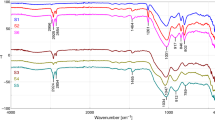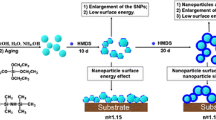Abstract
Reflection is a fundamental optical phenomenon, which occurs when light propagates across a boundary between two media that have different refractive indices. Using layer systems consisting of thin films with thickness in the range of light wavelength, it is possible to reduce the reflected light to below 0.2% by destructive interference. For this application, silica films were prepared from the mixture of a polymerized tetraethoxysilane (TEOS) sol and a polymerized methyltriethoxysilane (MTES) sol. The surface morphology of the coatings could be controlled by changing the molar ratio of both precursors, and the hydrophobic methyl groups in the silica network caused micro-phase separation. The refractive index of the film with the porous morphology could be controlled by preparation conditions, such as the kind of solvents, the relative humidity of the atmosphere, and the heat treatment temperature. Low-reflective glasses with visible light reflectance of 0.2% could be obtained by applying the present porous silica films with a refractive index of 1.23 to a soda-lime-silica glass substrate.
Access this chapter
Tax calculation will be finalised at checkout
Purchases are for personal use only
Similar content being viewed by others
References
Ashley C, Reed S. U.S. Patent 4929278. 1990.
Floch H, Belleville P. A scratch-resistant single-layer antireflective coating by a low temperature sol-gel route. J Sol-Gel Sci Technol. 1994;1:293–304.
Hara K., Inazumi T, Izumitani T. Application of sol-gel derived silica films containing a methyl radical to a slab laser. J. Non-Cryst. Solids. 1988;100:490–93.
Kollmorgan F. Light transmission through telescopes. Trans Illumin Engng Soc. 1916;11:220–34.
Li H, Wang A, Das S. Coating composition, process for producing antireflective coatings, and coated articles. US Patent 5,580,819. Dec 3, 1996.
Macleod H. Thin-film optical filters. 2nd ed. New York: McGraw Hill Publishing; 1989. p. 48.
Mukherjee SP, Lowdermilk WH. Gel-derived single layer antireflection films. J. Non-Cryst Solids 1982;48:177–84.
Nakanishi K, Soga N. Phase-separation in gelling silica organic polymer-solution-systems containing poly(sodium styrenesulfonate). J Am Ceram Soc. 1991;74:2519–530.
Nakanishi K, Soga N. Phase-separation in silica sol-gel system containing polyacrylic-acid. 3. Effect of catalytic condition. J Non-Cryst Solids. 1992;142:36–44.
Oliveira P, Krug H, Frantzen A, Mennig M, Schmidt H. Generation of wet-chemical AR-coatings on plastic substrates by use of polymerizable nanoparticles, Sol-Gel Optics IV, Dunn BS, Mackenzie JD, Pope EJA, Schmidt HK, Yamane M, editors. SPIE Proc. 1997;3136:452–61.
Ohishi T, Maekawa S, Ishikawa T, Kamoto D. Preparation and properties of anti-reflection/anti-static thin films for cathode ray tubes prepared by sol-gel method using photoirradiation. J Sol-Gel Sci Technol. 1997;8:511–5.
Ohno M, Yamada T, Kurokawa T. Micron-order relief-patterned silica glass using a sol-gel method. J Appl Phys. 1985;57:2951–62.
Ohno M, Yamada T, Takato N. Yogyo-Kyokai-Shi. 1986;94(7):644–650.
Pulker H. Coating on glass. American Elsevier; 1984. p. 92–270.
Sakka S. Fibers from the sol-gel process. In: Klein LC, editor. Sol-gel technology for thin films, fibers, preforms, electronics and specialty shapes. Park Ridge: Noyes Publications. p. 140–61.
Takahashi O, Yamazaki S, Arai H, Hamaguchi S. Sol-gel film and method for forming the same. Japanese Patent 298,545. Oct 25, 1994.
Thomas IM. High laser damage threshold porous silica antireflective coating. Appl Opt. 1986;25:1481–3.
Wada T, Sato Y, Suzuki K, Ando H, Chen D, Yan Y, Ono Y, Takamatsu M. Anti-reflections (AR) coating meter. SAE Technical Paper Series. 1999; 1999-01-0897.
Yoldas BE, Partlow DP. Wide spectrum antireflective coating for fused-silica and other glasses. Appl Optics. 1984;23:1418–24.
Author information
Authors and Affiliations
Corresponding author
Editor information
Editors and Affiliations
Rights and permissions
Copyright information
© 2018 Springer International Publishing AG, part of Springer Nature
About this entry
Cite this entry
Yamazaki, S. (2018). Sol‐Gel-Prepared Antireflective Coatings. In: Klein, L., Aparicio, M., Jitianu, A. (eds) Handbook of Sol-Gel Science and Technology. Springer, Cham. https://doi.org/10.1007/978-3-319-32101-1_97
Download citation
DOI: https://doi.org/10.1007/978-3-319-32101-1_97
Published:
Publisher Name: Springer, Cham
Print ISBN: 978-3-319-32099-1
Online ISBN: 978-3-319-32101-1
eBook Packages: Chemistry and Materials ScienceReference Module Physical and Materials ScienceReference Module Chemistry, Materials and Physics




